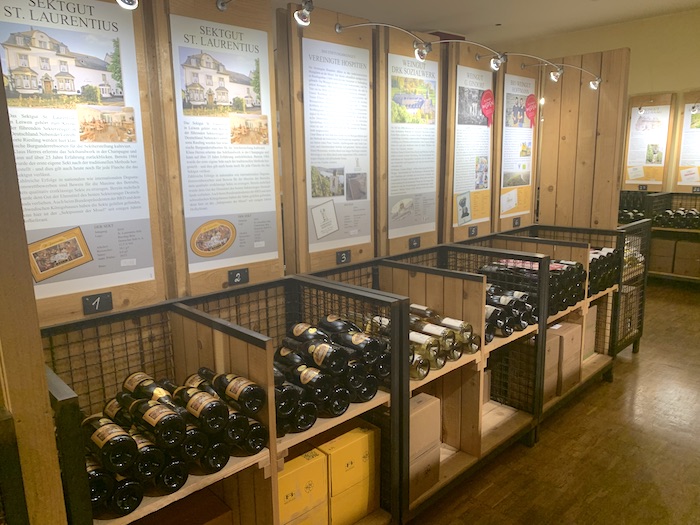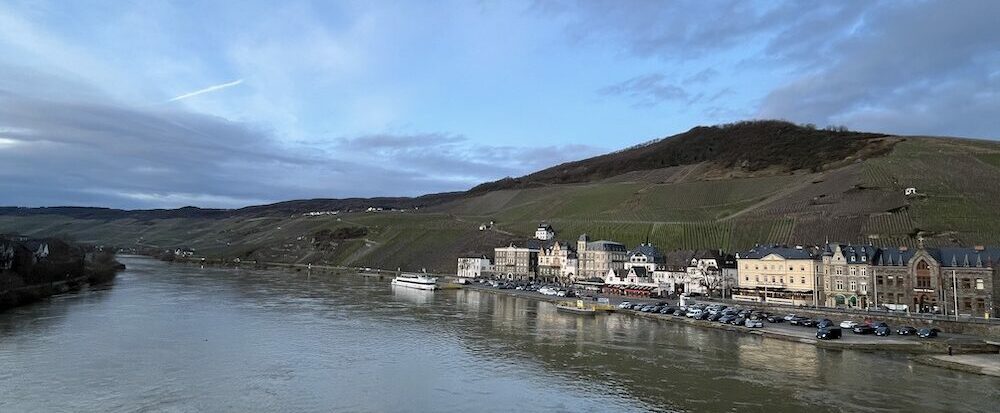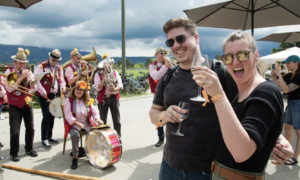The wine world is a snobby sort of place, full of poseurs, snobs and dilettantes. “Oh, I only drink Amarone made from the last shriveled grapes of the season, picked by barefoot peasants on the eastern hillsides of Piacenza.”
We have friends who spend serious money to visit Napa, Italy’s wine regions and Bordeaux, and who buy cases of Chateau Margaux and Stags Leap District cabs through brokers (I’m looking at you, Steve.) At the other extreme, we buy most of our wine at Lidl, though I have to admit to a soft spot for affordable German white wines from the Mosel and Rhine.
Now, there’s not much snob appeal to that, and that’s a good thing.
Any schmuck can get in their car and drive down to Wiesbaden, meander down the Rhine to Koblenz then head down the Mosel to Trier.
We did a bit of that this spring, a Quick Trip down to Trier from our home in the Netherlands, then on to Luxembourg and back to Eindhoven.
Nostalgia
This was a trip dedicated to nostalgia … revisiting some of our favorite places from our time living in Germany from 2002 to 2007.
Back in the day, we were based in a town called Baumholder, which – if you’re prior military – you’ll know as the home of the U.S. Army’s 1st Armored Division in Germany and part of the Kaiserslautern/Ramstein American military communities.
With kids, our travel options were always a bit limited. But we found out pretty quickly that Germany has so much to see.
I worked a lot in Wiesbaden, and a German colleague, Peter, showed me the ropes on where to find great white wines. We also had lots of friends who went to the wine villages along the Rhine and Mosel.
There are multiple “wine roads,” and the stretch with (arguably) the most scenic cities starts southwest of Wiesbaden in Rüdeshiem am Rhein. Rüdesheim (which the American invariably mispronounce as “rudesh-heim) is a huge tourist attraction for Germans and Americans based in Germany because of the scenery and because it’s a major wine center, most famous for Rieslings.
Our favorite place is the huge and glossy Schloss Johannisberg in Geisenheim, 30 minutes down the Rhine from Wiesbaden, which has a restaurant, events space and a huge vineyard. This is a very polished place that hosts a lot of business events. It’s not inexpensive, but the wine really lives up to their marketing. So, it’s crazy crowded during the summer. So crowded that many times, we couldn’t get in. So, we’d drive a few minutes down the road to Gästatte Jos. Weis, which has fab food and inexpensive white wines with outside dining in a small garden.
The Mosel has soooo many fabulous wines, wineries, guesthouses.

Down the Mosel
Here’s the best of what we saw, which includes at least one stop for household goods in Sohren, a one-horse town you’d only know about if you’re prior military or you take Ryan Air flights out of nearby Hahn Airport. In Sohren, you’ll find Kaefer Sohren, a family-owned outlet with an amazing inventory of discounted high-end goods, ranging from deLonghi espresso makers for as much as you want to spend to Versace plates for 289 euros to closeout glassware they’re practically giving away.
Staying with our wine theme, we bought four wine glasses, as well as eight bourbon glasses, a crystal vase and cocktail glasses perfect for Aperol Spritz and left with a relatively painless tab of 90 euros.

From Sohren, we took a 30-minute drive west to Bernkastel-Kues, which is actually two ancient towns across the Mosel from each other. This is a place we know well, only an hour’s drive north of Heimbach, where we lived in the hills of the Hunsrück, and a great place to take friends from the U.S. for authentic German food and ancient castles on the river.
Bernkastel-Kues is a great gateway to the rest of the cities along the Mosul down to Trier, about 45 minutes southwest. The most famous and spectacular of the Middle Mosel’s famous vineyards stretch from Brauneberg in the south, through Lieser, Bernkastel-Kues, Wehlen, Graach, Zeltingen, Ürzig,Erden, Wolf, Traben-Trarbach and Reil.
Bernkastel-Kues itself is surrounded by vineyards and wineries. Just drive up the river or down the river. They’re all going to have great wine because most are small batch operations. They’re also amazingly affordable compared to Napa or even French wines of comparable quality.
For instance, Studert Prüm Maximinhof is one of the more highly rated wines from the Bernkastel-Kues vineyards. Prices at the winery range from seven to nine euros. That said, you can find plenty of places to spend 100 euros or more (way more) per bottle. If that’s you, check out Bernkasteler Doctor in Bernkastel-Kues, probably the most celebrated (and expensive) tipple along the Mosel.
These are some of the world’s best vineyards, producing spectacular wines, predominantly white Riesling, but also some fine Spätburgunders (Pinot noir). This is also home to some of the world’s best wine makers, including Dr. Loosen, JJ Prüm and Markus Molitor.

Trier
Or you can do what we did and just drive down to Trier and hit the winestubbes and restaurants, where you can sample the top wines from the region for amazingly affordable prices.
We can heartily recommend Oechsle Wine and Fishhouse back in a quiet alley in Trier.
This restaurant was an affordable place for a great fish dinner, and it had one of the most amazing wine selections we saw on our trip, with rows and rows of cases from the region’s vineyards and vintners.
We spent about 60 euros on dinner and a couple of glasses of Reisling from Vereinigte Hospitien, reputed to be the oldest cellar in Germany.
The great thing about this region of Germany is it offers endless opportunities – memorable scenery that will have you coming, insanely good wines at reasonable prices and endless options for dining and affordable places to stay.
Where we stayed:
We stayed at Holiday Trier City, which are fully furnished apartments on the Simeonstrasse. Our apartment view was the Porta Nigra, so the location was perfect. It was a large apartment, well appointed, clean and with everything we needed. We booked through booking.com and paid 243 euros for two nights in early March. Could we have found something cheaper? Probably. But we like to have more space rather than hotel amenities, and this was a great find for the price.
––––––––––
Read more about wine here in Dispatches’ archives.
Read more about Germany here.
Co-CEO of Dispatches Europe. A former military reporter, I'm a serial expat who has lived in France, Turkey, Germany and the Netherlands.










